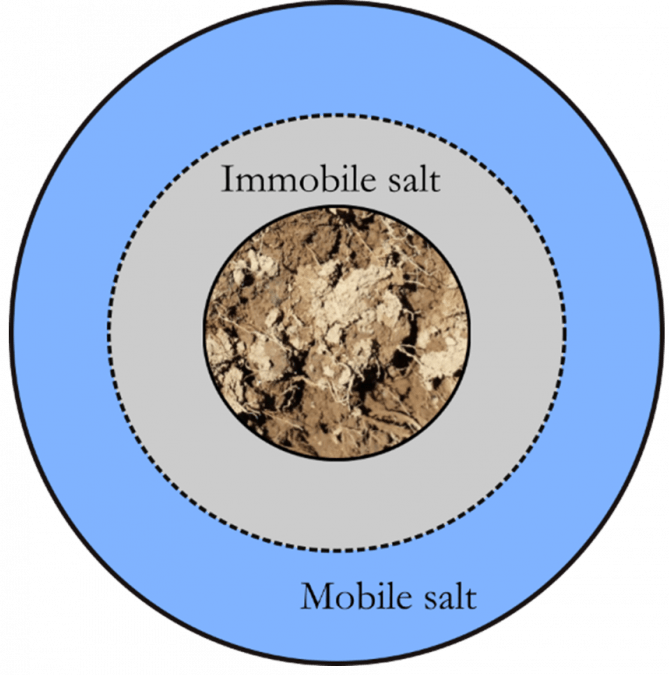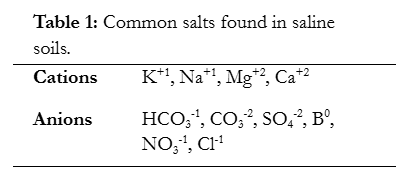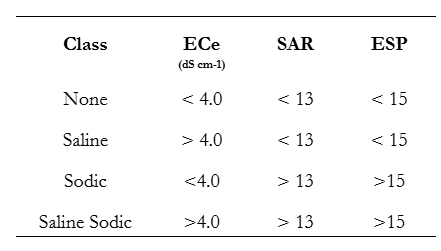
Fact Sheets And Publications
Salt Measurements and Soil Classifications
Revised September 2025 | Written by: Jarrod Miller
Cation Exchange Capacity and Salts
Soils have a natural characteristic called the cation exchange capacity (CEC) that allows them to hold (and exchange) cations (e.g., Ca+2 or Na+). These cations are held tight enough on the CEC that they do not easily leach, but the electrostatic attraction is weak enough to allow them to be exchanged with other cations. The cations on the CEC are in equilibrium with the pore water, so that most Ca+2 will be on the CEC and some will be in the pore water. Any soluble salts in the pore water will be plant available, but also mobile and able to leach from the root zone (Figure 1).

Figure 1. (left) The grey area around the soil particle represents the zone of CEC which can hold positvely charged salts. Salts out in the pore water (blue) affect roots and are also likely to leach.
The concept of CEC is important when considering salinity, since roots will interact with pore water. High concentrations of salts in the pore water will have adverse effects on plant growth and soil physical characteristics. This differentiation is important when considering how we measure salts in the soil.
Measuring Salts
Salts can be extracted from the soil by many methods, including water or acids. Dissolved ions in the soil solution are the most likely to be extracted by water and would give a good indication of what the plant root is experiencing. To measure soil salinity, a common test involves an extraction of one part soil to one part water, also known as a paste or saturation extraction. The water will then be filtered (separated) from the soil and measured for dissolved ions such as Na+1 or Cl-1. In comparison, CEC is typically measured by washing the soil with an exchangeable salt (e.g., ammonium acetate) or an acid extraction. This is because exchangeable ions held on the CEC will not be easily extracted by water.
Most comparisons of plant growth to salt concentrations are based on saturation extractions since they will reveal what the plant root is experiencing in the pore water. These water extractions will be examined for soluble cations and anions (Table 1), pH and electrical conductivity (EC). Soluble salts in a water solution carry a charge and they will conduct an electrical current. Therefore, as the salt concentration of the saturation extract increases, so will the EC.

Salt-Affected Soil Classifications
The standard classifications of soil salinity (saline, sodic, saline-sodic) are based on saturated paste and ammonium acetate extractions. Both the pH and EC of the saturation extract can be used to classify saline soils and are commonly labeled by the subscript “e” (i.e. pHe and ECe) to differentiate from the standard 1:1 soil water solution. The cations in the extract can be compared using the sodium adsorption ratio (SAR):

which is also useful for irrigation water. Another soil property that is used to classify salinity is the exchangeable sodium percentage (ESP), which is based off the % Na on the soil CEC.
Classification of salt-affected soils in the United States can be found in Table 2 and are based on measurements above or below an ECe of 4.0 dS cm 1, a SAR of 13, an ESP of 15%, and pH 8.5. Classifications are listed below as:
No Salt Affects: Soils with normal or nominal salt levels will have an EC less than 4.0 dS cm-1, but preferably with an EC less than 2.0. They will also be below thresholds for SAR (13), ESP (15%), and pH (8.5).
Saline Soils: Soils that have a high enough salt concentration to start affecting plant growth will have an EC greater than 4.0 dS cm-1. These soils will have high concentrations of several salts (e.g., Ca+2, Mg+2, Cl-, HCO3-, etc.) and not just Na+. Therefore, they will have values below the thresholds for SAR (13), ESP (15%), and pH (8.5).
Table 1: Classification of salt-affected soils in the USA saturated paste by electrical conductivity (ECe), sodium absorption ratio (SAR), and exchangeable sodium percentage (ESP). Soils with a pH > 8.5 are sodic.

Sodic Soils: Soils that are dominated by the salt Na+ are classified as sodic (or alkali in older literature). They do not have an EC greater than 4.0 dS cm-1, but will have values above the thresholds for SAR, ESP, and pH. Sodic soils will maintain a pH greater than 8.5 because Na2CO3 is soluble and more carbonate (CO3-2) remains in solution. In soils dominated by Ca+2 or Mg+2, carbonate will precipitate as limestone and keep the pH < 8.5.
Saline-Sodic Soils: Soils that are high in several salts, as well as Na will have high EC, SAR, and ESP values, but still maintain a pH less than 8.5. These high salt soils are described as saline-sodic to denote both the high salt and sodium content.
Salinity and Mid-Atlantic Soil Tests
The soil tests for salinity are more expensive and often only performed by labs in the western United States. In the Mid-Atlantic, the Mehlich3 (M3) extraction is commonly used and would not produce Na+, Ca+2, or Mg+2 values related to known SAR thresholds. An updated conversion of either the EC1:2 or EC1:5 to ECe has been published for the Mid-Atlantic (Pokhrel et al., 2025):

The most useful value for the Mid-Atlantic may be the ESP (%Na) based on the M3 extraction. While it has not currently been evaluated for any relationship to plant growth and soil quality, it may be the most comparable to standard salinity classifications.
This outreach was supported by USDA-NIFA: 2018-68002-27915.
Reviewed by:
Dr. Amy Shober and Mr. Jake Jones
References
Cardon, G.E., J.H. Davis, T.A. Bauder, and R.M. Waskom. 2014. Managing saline soils. Colorado State Extension. Factsheet 0.503
Cassidy, N.G. 1968. The effect of cyclic salt in a maritime environment I. The salinity of rainfall and of the atmosphere. Plant and Soil. 28:106-128.
Pokhrel, S., Blew, W., Miller, J. O., & Shober, A. L. (2025). Evaluating routine agronomic soil tests for coastal soil salinity detection in the mid-Atlantic. Soil Science Society of America Journal, 89, e70075. https://doi.org/10.1002/saj2.70075
UD Cooperative Extension
This institution is an equal opportunity provider.
In accordance with Federal law and U.S. Department of Agriculture policy, Cooperative Extension is prohibited from discriminating on the basis of race, color, national origin, sex, age, or disability.
